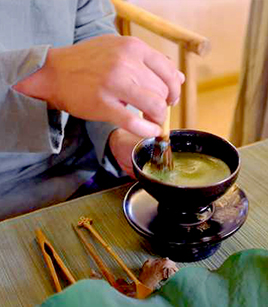Methods of jiancha and diancha

Brewing tea in the way of diancha Photo: CCTV
The tea culture of the Tang and Song era was characterized by two distinctive tea drinking methods, serving as proof that there were sophisticated and formal tea drinking traditions at that time.
According to The Classic of Tea written by Lu Yu (c. 733–804), the tea drinking method favored by the Tang people was called sanfei jiancha fa. The first step was to evenly toast the tea cake over an open flame. When cooled, the tea cake was crushed and passed through a sieve to extract the fine powder. Water was boiled until fish-eye sized bubbles appeared, what Lu called ‘yi fei’ (first boil), and salt was added. The second boil, or ‘er fei,’ is characterized by strings of bigger pearl bubbles at the edge of the pot. At this stage, one scoop of water was reserved, and a bamboo tool was used to stir the water to create a swirl. The prepared tea powder should be put into this swirl by using a spoon-shaped tool (ze). ‘San fei’ (the third boil) came when the water boiled like a rough sea, then the scoop of water removed earlier should be added back in to prevent boiling over and to produce the essence of the tea. The final step was to ladle tea into tea bowls and serve.
Diancha fa was a popular tea drinking method in the Song Dynasty. It started with grinding and sieving tea for the finest powder and putting it in a teacup. After pouring a small amount of boiling water in the teacup to make a paste, more boiling water should be poured into the cup. The next step was the most important step: stir the mixture with a bamboo tea whisk (cha xian), and repeat this process seven times until the tea and water were completely mixed and thick froth appeared. The diancha method was universally popular and there were even tea contests (dou cha) to evaluate tea quality which measured the color of the tea liquor [the whiter the better] and the water mark on the inside of the cup. If the tea was ground finely, with optimal pouring and whisking skills, the tea froth would be fine and stay on the inside of the cup for a long time. It is believed that Japanese monks in China brought this drinking method back to Japan and developed it into the Japanese tea ceremony we see today.
